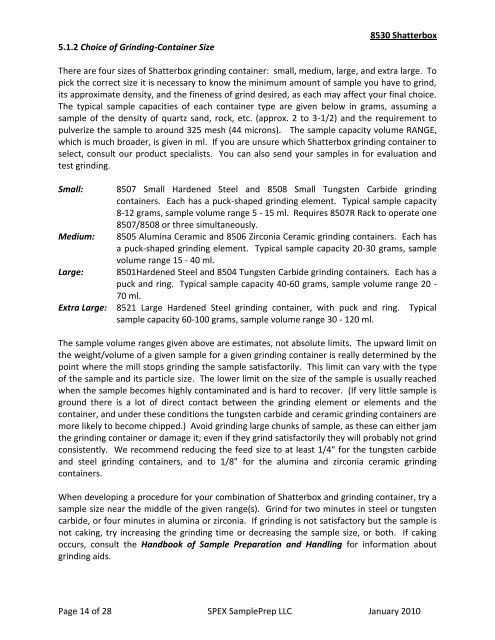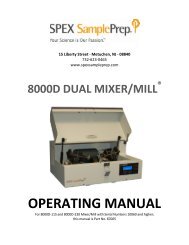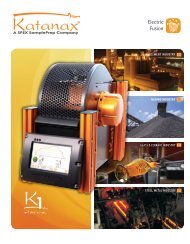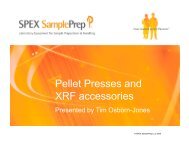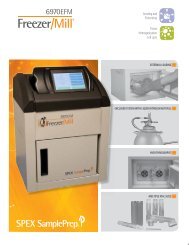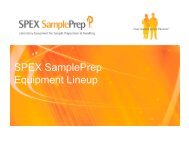8530 Shatterbox Manual 100713 abridged - SPEX SamplePrep
8530 Shatterbox Manual 100713 abridged - SPEX SamplePrep
8530 Shatterbox Manual 100713 abridged - SPEX SamplePrep
You also want an ePaper? Increase the reach of your titles
YUMPU automatically turns print PDFs into web optimized ePapers that Google loves.
5.1.2 Choice of Grinding-Container Size<strong>8530</strong> <strong>Shatterbox</strong>There are four sizes of <strong>Shatterbox</strong> grinding container: small, medium, large, and extra large. Topick the correct size it is necessary to know the minimum amount of sample you have to grind,its approximate density, and the fineness of grind desired, as each may affect your final choice.The typical sample capacities of each container type are given below in grams, assuming asample of the density of quartz sand, rock, etc. (approx. 2 to 3-1/2) and the requirement topulverize the sample to around 325 mesh (44 microns). The sample capacity volume RANGE,which is much broader, is given in ml. If you are unsure which <strong>Shatterbox</strong> grinding container toselect, consult our product specialists. You can also send your samples in for evaluation andtest grinding.Small:Medium:Large:8507 Small Hardened Steel and 8508 Small Tungsten Carbide grindingcontainers. Each has a puck-shaped grinding element. Typical sample capacity8-12 grams, sample volume range 5 - 15 ml. Requires 8507R Rack to operate one8507/8508 or three simultaneously.8505 Alumina Ceramic and 8506 Zirconia Ceramic grinding containers. Each hasa puck-shaped grinding element. Typical sample capacity 20-30 grams, samplevolume range 15 - 40 ml.8501Hardened Steel and 8504 Tungsten Carbide grinding containers. Each has apuck and ring. Typical sample capacity 40-60 grams, sample volume range 20 -70 ml.Extra Large: 8521 Large Hardened Steel grinding container, with puck and ring. Typicalsample capacity 60-100 grams, sample volume range 30 - 120 ml.The sample volume ranges given above are estimates, not absolute limits. The upward limit onthe weight/volume of a given sample for a given grinding container is really determined by thepoint where the mill stops grinding the sample satisfactorily. This limit can vary with the typeof the sample and its particle size. The lower limit on the size of the sample is usually reachedwhen the sample becomes highly contaminated and is hard to recover. (If very little sample isground there is a lot of direct contact between the grinding element or elements and thecontainer, and under these conditions the tungsten carbide and ceramic grinding containers aremore likely to become chipped.) Avoid grinding large chunks of sample, as these can either jamthe grinding container or damage it; even if they grind satisfactorily they will probably not grindconsistently. We recommend reducing the feed size to at least 1/4" for the tungsten carbideand steel grinding containers, and to 1/8" for the alumina and zirconia ceramic grindingcontainers.When developing a procedure for your combination of <strong>Shatterbox</strong> and grinding container, try asample size near the middle of the given range(s). Grind for two minutes in steel or tungstencarbide, or four minutes in alumina or zirconia. If grinding is not satisfactory but the sample isnot caking, try increasing the grinding time or decreasing the sample size, or both. If cakingoccurs, consult the Handbook of Sample Preparation and Handling for information aboutgrinding aids.Page 14 of 28 <strong>SPEX</strong> <strong>SamplePrep</strong> LLC January 2010


